Laurium
Laurium or Lavrio (Greek: Λαύριο; Ancient Greek: Λαύριον; before early 11th century BC: Θορικός Thorikos; from Middle Ages until 1908: Εργαστήρια Ergastiria)[2] is a town in southeastern part of Attica, Greece. It is part of Athens metropolitan area and the seat of the municipality of Lavreotiki.[3] Laurium was famous in Classical antiquity for its silver mines, which was one of the chief sources of revenue of the Athenian state. The metallic silver was mainly used for coinage. The Archaeological Museum of Lavrion shows much of the story of these mines.
Laurium Lavrio Λαύριο | |
|---|---|
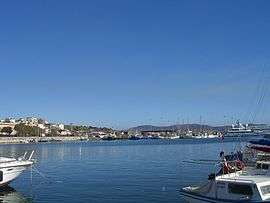 The port of Lavrio | |
 Laurium Lavrio | |
| Coordinates: 37°42′N 24°3′E | |
| Country | Greece |
| Administrative region | Attica |
| Regional unit | East Attica |
| Municipality | Lavreotiki |
| Highest elevation | 11 m (36 ft) |
| Lowest elevation | 0 m (0 ft) |
| Population (2011)[1] | |
| • Total | 7,078 |
| Time zone | UTC+2 (EET) |
| • Summer (DST) | UTC+3 (EEST) |
| Postal code | 195 xx |
It is located about 60 km SE of Athens city center, SE of Keratea and N of Cape Sounio. Laurium is situated on a bay overlooking the island of Makronisos (ancient times: Helena) in the east. The port is in the middle and gridded streets cover the residential area of Lavrio. GR-89 runs through Lavrio and ends south in Sounio.
History
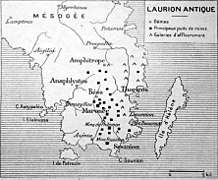
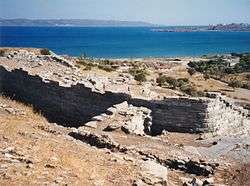
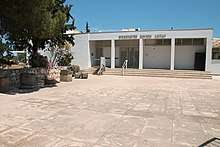
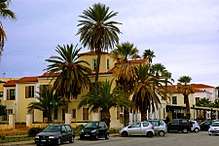
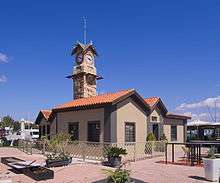
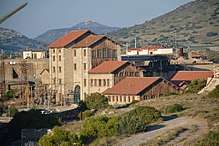

The modern town of Laurium is at the site of the ancient village of Thoricus; its name is taken from that of the entire region of the Mines of Laurium.
The earliest evidence for mining dates to the beginning of the Bronze Age, ca. 3200 BC.[4]
Systematic exploitation of mineral resources seem to have begun in the 6th century BC under Peisistratus. After the battle of Marathon, Themistocles persuaded the Athenians to devote the anticipated revenue derived from a major silver vein strike in the mines of Laurion circa 483 BC to expanding the Athenian fleet to 200 triremes, and thus laid the foundation of the Athenian naval power. The mines, which were the property of the state, were usually farmed out for a certain fixed sum and a percentage on the working; slave labour was exclusively employed. An unrecorded number were children. It was a miserable, dangerous, and brief life. As many as 20,000 slaves were employed at the height of the mining. A silver mint (Argyrocopeum) was at Laurion.
Towards the end of the 5th century, the output fell, partly owing to the Spartan occupation of Decelea. But the mines continued to be worked, though Strabo records that in his time the tailings were being worked over, and Pausanias speaks of the mines as a thing of the past. The ancient workings, consisting of shafts and galleries for excavating the ore, and washing tables for concentrating the ore, may still be seen at many locations. There were well engineered tanks and reservoirs to collect rainwater for washing the ore since abundant supplies from streams or rivers was impossible at the site. The mines were reworked in the early 20th century by French and Greek companies, but mainly for lead, manganese and cadmium. The Mineralogical Museum of Lavrion comprises samples of minerals from the region of Lavrion.
Facilities
The Eleftherios Venizelos International Airport is 35 km away from Lavrio or about 30 minutes drive. Lavrio is connected to Athens by car using the Lavrio/Sounio Leoforos (Highway) and then Attiki Odos. This trip takes about an hour. A quite convenient solution to go to Athens is to "park and drive". Drive from Lavrio to Koropi Train Station and there take the train proastiakos or metro that goes straight to Athens center. (30 minutes drive + 30 minutes train)
Lavrio was the terminal station of the Athens-Lavrion Railway, which was abandoned in 1957.
The mining town of Laurium, Michigan was named after the famous Greek Laurium.
Sports
Laurium hosts the football club Olympiacos Laurium, which played in the Gamma Ethniki in the past, and the basketball club Lavrio B.C., which plays in the Basket League.
| Sport clubs based in Laurium | |||
|---|---|---|---|
| Club | Founded | Sports | Achievements |
| Olympiacos Laurium | 1926 | Football | Previous presence in Gamma Ethniki |
| Lavrio B.C. | 1990 | Basketball | Current presence in Basket League |
Twin towns
See also
- List of municipalities of Attica
References
- "Απογραφή Πληθυσμού - Κατοικιών 2011. ΜΟΝΙΜΟΣ Πληθυσμός" (in Greek). Hellenic Statistical Authority.
- "EETAA local government changes". eetaa.gr. Retrieved 26 June 2020.
- Kallikratis law Greece Ministry of Interior (in Greek)
- "Newly Discovered Greek Silver Mine Rewrites History - GreekReporter.com". greece.greekreporter.com. Retrieved 20 April 2018.
Sources
- Édouard Ardaillon, "Les Mines du Laurion dans l'antiquité", No. Ixxvii. of the Bibliothéque des Ecoles francaises d'Athênes et de Rome.

External links
| Wikimedia Commons has media related to Laurium. |